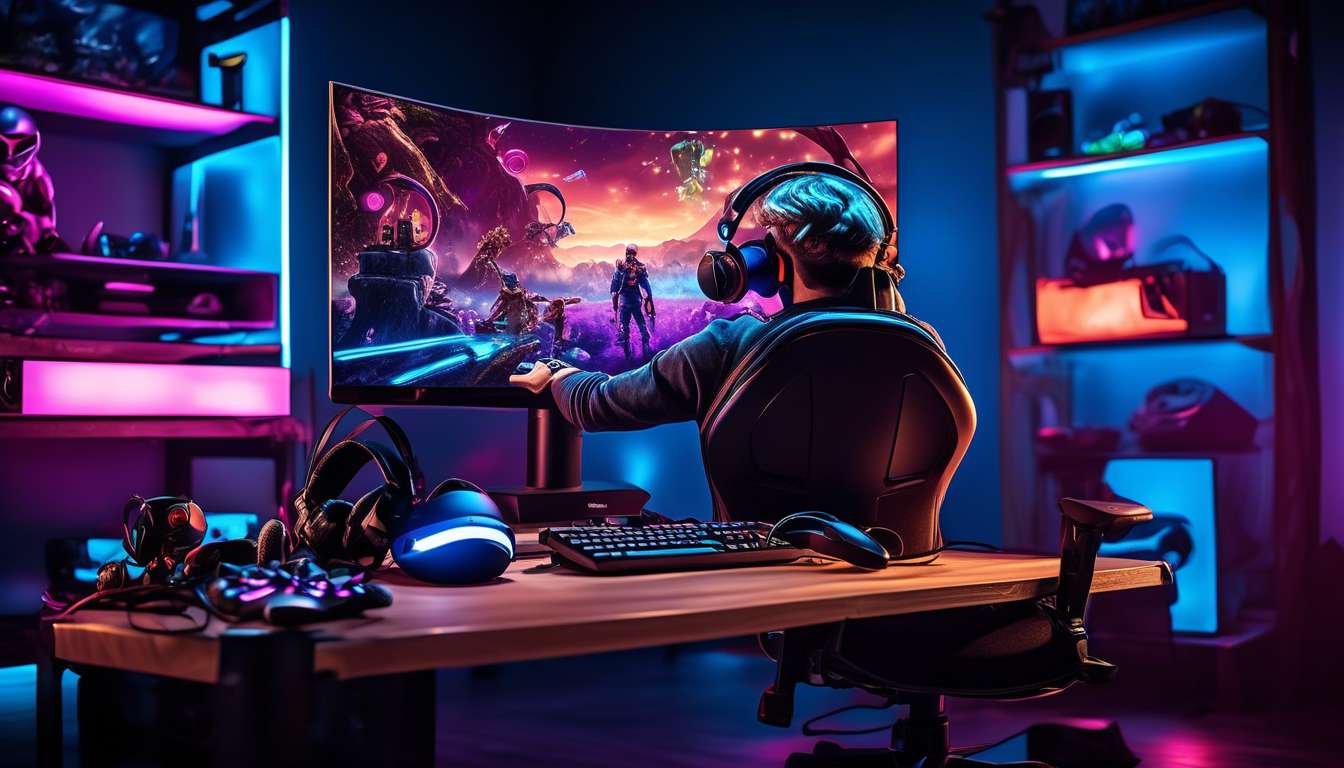As we look back at the gaming landscape of 2020, we find ourselves reflecting on a year that transformed our virtual worlds in unprecedented ways. Together, we witnessed a surge in gaming popularity, fueled in part by the global circumstances that drove many of us to seek connection and entertainment online.
We immersed ourselves in a variety of trends that captured our collective imagination.
- The meteoric rise of social simulation games like "Animal Crossing: New Horizons"
- The explosive popularity of battle royale games such as "Fortnite" and "Call of Duty: Warzone"
These experiences showcased a diverse array of gaming phenomena that redefined how we play.
Streaming platforms and esports continued to grow, bringing us closer to the action and to each other.
As we delve into these trends, let us explore how they not only shaped our gaming experiences but also brought us together in a year like no other.
Rise of Social Simulation Games
In 2020, we saw a significant surge in the popularity of social simulation games as players sought virtual communities and creative outlets. These games offered us the chance to connect with others in a world where physical gatherings were limited. We found solace in building our own worlds and nurturing connections with friends, both old and new. Social simulation games provided a space where we could express ourselves freely and form bonds with like-minded individuals.
The rise of these games even impacted the Esports scene. Although traditionally dominated by competitive genres, Esports began to embrace social simulation games, hosting events that celebrated creativity and community engagement. This shift demonstrated that gaming isn’t just about competition; it’s also about connection and belonging.
Moreover, cross-platform compatibility further fueled the growth of social simulation games. We could play with friends across different devices, breaking down barriers and fostering inclusivity. This accessibility allowed us to unite, share experiences, and create lasting memories, no matter where we were.
Popularity of Battle Royale Games
In 2020, battle royale games surged in popularity, captivating millions with their dynamic gameplay and competitive thrill. As a community, we found ourselves drawn to the excitement of these virtual battlegrounds, where strategic thinking and quick reflexes became our shared passion.
The thrill of outlasting opponents and claiming victory resonated deeply with us, fostering a sense of camaraderie and connection. Battle royale games offered more than just action; they became social simulations where we could engage with friends and strangers alike, forging bonds through shared experiences.
These games evolved into a core part of Esports, with tournaments bringing together players from every corner of the globe. The cross-platform capabilities ensured that no matter our device, we could join the fray alongside our friends, breaking down barriers and uniting us in play.
As we embraced this trend, battle royale games became a staple in our gaming lives, offering both challenge and community.
Growth of Streaming Platforms
In 2020, streaming platforms experienced a significant surge in growth, revolutionizing how we shared and consumed gaming content.
As a community passionate about gaming, we found ourselves more connected than ever, thanks to platforms like Twitch and YouTube Gaming. These platforms did not just offer a place to watch gameplay; they became social hubs where we could engage with our favorite streamers and fellow fans in real time.
The rise of social simulation games allowed us to explore new worlds together, blurring the lines between players and viewers.
Streaming also played a crucial role in the rise of Esports, enabling us to participate in global events from the comfort of our homes. The cross-platform capabilities of these streaming services meant:
- We didn’t have to worry about which device we used.
- We could all join in, regardless of our setup.
This inclusivity fostered a sense of belonging, bringing us closer as a vibrant, diverse gaming community.
Expansion of Esports Scene
In 2020, we witnessed a dramatic expansion in the esports scene, with countless tournaments and leagues captivating audiences worldwide. As we gathered online to cheer for our favorite teams, esports became more than just competition; it became a community where we all felt at home.
Cross-platform titles allowed players from different systems to unite, breaking barriers and fostering a sense of belonging. Games like these transformed esports into a universal language we all spoke.
Social simulation games, traditionally seen as solo experiences, started integrating esports elements. They invited players to engage in competitive play while maintaining their narrative charm. This fusion attracted diverse audiences, merging casual and competitive gamers into one vibrant tapestry. We found camaraderie in shared experiences, whether strategizing in-game or celebrating victories together.
By embracing cross-platform capabilities and including social simulation aspects, the esports scene grew more inclusive. We discovered that, in this evolving digital arena, there’s a place for everyone to belong.
Surge in Multiplayer Online Games
In 2020, multiplayer online games experienced a significant surge as players sought new ways to connect and compete globally. This trend was driven by our desire for a sense of community and belonging, especially when physical gatherings were limited.
Games offering social simulation became particularly popular, allowing us to:
- Create and explore virtual worlds together
- Foster friendships
- Share experiences
The explosive growth of Esports also played a crucial role in this trend. We saw players coming together to:
- Form teams
- Compete in tournaments
- Showcase skills on a global stage
This competitive spirit brought us closer and created vibrant online communities where we could share our passion for gaming.
Furthermore, the rise in cross-platform capabilities allowed us to:
- Join friends across different devices
- Break down barriers
- Make gaming more inclusive
This inclusivity ensured that no one was left out of the fun and camaraderie.
Inclusion of Cross-Platform Play
Developers have embraced cross-platform play, allowing us to seamlessly connect and game with friends regardless of their chosen devices. This trend breaks down barriers, making our gaming experiences more inclusive and unified.
Whether we’re diving into a social simulation game or competing in high-stakes esports, the ability to play alongside friends on different platforms amplifies our sense of community and belonging.
Cross-platform play has transformed how we engage with games and each other. It fosters a vibrant, interconnected community where we can share victories and strategies without being limited by consoles or PCs.
- We’re seeing more games adopt this feature, ensuring that no one feels left out due to their hardware preferences.
In esports, cross-platform capabilities level the playing field, bringing diverse players together and enhancing competitive integrity.
As we continue to explore new gaming landscapes, cross-platform play stands as a testament to the power of inclusion, allowing us to create richer, more dynamic experiences together.
Embrace of Virtual Reality Experiences
Virtual reality experiences have revolutionized the way we immerse ourselves in gaming, offering unprecedented levels of interaction and realism. This technology allows us to connect with our community in ways we’ve only dreamed of before.
VR’s Transformative Power:
- Transports us into lifelike worlds.
- Creates a sense of camaraderie and shared adventure.
- Blurs the lines between digital and reality.
Whether we’re engaging in social simulation games or competing in intense esports tournaments, VR brings us closer.
Our shared enthusiasm for VR has driven developers to create cross-platform experiences that bond us, regardless of the hardware we own.
Key Benefits of Cross-Platform Experiences:
- Inclusivity strengthens our community.
- Ensures everyone feels part of the gaming evolution.
As we dive into these immersive environments, we’re not just players; we’re pioneers exploring new frontiers. Together, we push the boundaries of what’s possible, making VR not just a trend, but a cornerstone of our collective gaming journey.
Impact of Game Accessibility Features
A growing focus on accessibility features in gaming ensures more players can enjoy and participate in the experiences we cherish. As gamers, we know that the joy of exploring new worlds and connecting with friends shouldn’t be limited.
With advancements in accessibility, games now offer:
- Customizable controls
- Text-to-speech options
- Visual aids
These features allow everyone to engage fully.
Social simulation games become more inclusive, inviting us all to create and share vibrant virtual lives without barriers.
In the realm of esports, accessibility features level the playing field, empowering diverse talent to compete and shine. We see a more inclusive community where players, regardless of physical abilities, can rise through the ranks and inspire others.
Cross-platform play plays a pivotal role in uniting us by:
- Breaking down barriers between different consoles and devices
- Allowing us to game together, regardless of our setups
As accessibility continues to evolve, our gaming family grows stronger and more connected.
What were the most anticipated game releases in 2020 besides those in popular genres?
We were eager for game releases in 2020 that stepped outside popular genres. Unique titles like "Cyberpunk 2077" and "Ghost of Tsushima" had us excited.
These games promised fresh experiences and innovative gameplay that captivated our attention. Their anticipation among us reflected a desire for diversity and creativity in the gaming industry.
It was refreshing to see developers pushing boundaries and offering new narratives to explore.
How did the COVID-19 pandemic influence game development timelines in 2020?
The COVID-19 pandemic drastically impacted game development timelines in 2020. Our team had to quickly adapt to remote work setups, leading to some initial delays as we adjusted to new workflows.
However, thanks to our collective efforts and dedication, we managed to overcome these challenges and find innovative ways to collaborate effectively.
Ultimately, this experience strengthened our team’s resilience and brought us closer together, resulting in a successful year despite the obstacles we faced.
What role did indie games play in the gaming landscape of 2020?
Indie games brought fresh creativity and innovation to the gaming scene in 2020. They provided unique experiences that resonated with many players, offering a welcome change from mainstream titles.
As a result, indie games played a significant role in diversifying the gaming landscape and showcasing the talents of independent developers.
- Their impact was felt across the industry, reminding us of the power of creativity and originality in gaming.
Conclusion
As you wrap up this exploration of popular gaming trends in 2020, remember to keep up with the evolving landscape.
Embrace the Trends:
- Social simulation games
- Battle royale showdowns
- Virtual reality adventures
Stay Connected:
- Streaming platforms
- Thriving esports community
- Multiplayer online games camaraderie
Exciting Developments:
- Cross-platform play
- Improved accessibility features
With these advancements, the world of gaming is more inclusive and exciting than ever. Keep gaming and stay ahead of the curve!

